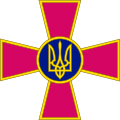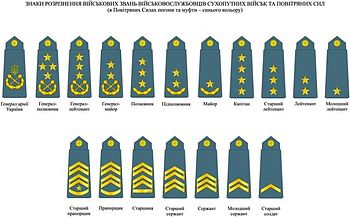|
Military ranks of Ukraine
The military ranks of the Armed Forces of Ukraine (AFU) were established in March 1992, when Ukraine adopted the Law on Military Duty and Military Service 1992.[1] The Ukrainian Armed Forces have two styles of ranks:
Whilst previously Ukraine maintained a USSR-style system, its current system follows a NATO standardization. Current military rank insigniaIntroduction of NATO-style ranksOn 17 October 2019, the parliament of Ukraine approved a change in the rank structure of enlisted men in order to conform to the NATO STANAG 2116 standardization. The change was implemented with the 2020 military reform.[2] This resulted in the abolition of the rank of General of the Army of Ukraine by Law nr. 680-IX, on 1 October 2020.[3] Effective 23 May 2023, the Marine Corps was separated from the Navy as an independent branch of the AFU. The Corps retained the shoulder and sleeve insignia inherited from the Navy, pending the introduction of a new set of insignia designs.[citation needed] Commissioned officer ranksThe following are the rank insignia of commissioned officers.
Student officer ranks
Other ranksThe rank insignia of non-commissioned officers and enlisted personnel.
NomenclatureCertain branches are suffixed with a descriptor indicating their specialty branch or if they are reservists or have retired.[6]
Formerly, air force ranks were suffixed with "of aviation". Similarly, guards unit ranks were prefixed "guards" following the rank of a serviceman of a guards unit. These descriptors have now been abolished.[citation needed] Former rank systems1991 systemUkraine inherited the ranks of the Soviet Union upon becoming independent, with some changes:
Officer ranks
Enlisted ranks
Proposed system 2009The first graduates of the Training Centre for Sergeants of the Armed Forces of Ukraine in Kharkiv became the first professional sergeants, who wore cloth shoulder straps with a new insignia.[7]
These changes were aimed to conform with NATO standards. Until 2009, Ukrainian soldiers used a military rank insignia of the Soviet model. Before the changes, a Ukrainian major general could be confused with an ordinary major, as they both had only one star on the Soviet straps. The new straps of major general have two stars, like in most NATO countries.[8] Also, the new system of military insignia makes possible to introduce new ranks, such as brigade general or new types of sergeant. New straps of generals have crossed maces (bulawas), which are kleinods (regalia) of Hetman, colonel and Otaman of the Host. These experimental insignia were never fully adopted and were abandoned shortly afterwards. Up until 2015 the Armed Forces kept using the Soviet-style insignia and rank system, albeit in the case of the Ground Forces and the Air Force the old insignia stayed with the officer corps while the 2009 proposal for NCO insignia saw wider adoption and thus replaced the Soviet insignia. Sergeant major (the post of chief sergeant)Chief sergeant of a branch of the armed forces is a projected post in Ukraine. The chief sergeant is a person who knows almost all issues that relate to non-commissioned officers. Therefore, the chief sergeant of a branch of the armed forces may be adviser to the head of the appropriate level – for example, the commander of land forces of Ukraine. The Ministry of Defence is working to change the statute and, possibly, the new post was projected to be introduced c. 2012–2013.[9] In airmobile units (now Ukrainian Air Assault Forces) there were also posts of chief sergeant of the division and chief sergeant of the brigade.
2016 systemIn late July 2015, President Petro Poroshenko stated that Ukraine needed to introduce new military ranks that meet Ukrainian military traditions "and corresponds to the structure of NATO military ranks".[10] However, the system then proposed replicated the Soviet hierarchy of military ranks and had no relation to the NATO system whatsoever, with only a cosmetic change to the shoulder strap insignia. The reform of 2016 was meant to achieve NATO standardization while honoring the traditions of Cossacks in Ukraine, the Ukrainian independence armies, and the Ukrainian People's Army of the Russian Civil War, the Ukrainian War of Independence, and the Second World War-era Ukrainian Insurgent Army, adapting their rank insignias to suit a modern AFU for the current times and beyond.[11]
While option 1 uses the old system but with new other ranks insignia, option 2 uses a US-style insignia for enlisted ranks, NCOs, and the Brigadier general rank. In both cases, all officers use pips while the General of the Army of Ukraine has the crossed Bulawa as insignia. Early proposals had the General of the Army shoulder insignia to use the state coat of arms.
In 2016, new rank insignia designs were issued for the Navy, which included both shoulder and sleeve insignia for all ranks.
Uniforms using the revised system debuted on 24 August 2016, as Ukraine marked the silver jubilee of nationhood.[12] The stars used for officers' ranking from the Soviet era were replaced with British military style diamonds – inspired by those used by the Ukrainian State of 1918. The Navy planned to phase-in new insignia by 2017, with a unified set shoulder and sleeve rank insignia similar to many NATO and European Union naval forces with distinctions:
On 30 May 2019, the Verkhovna Rada (Ukrainian parliament) adopted as a basis Bill No. 10181 on the introduction of sergeant ranks in the Armed Forces of Ukraine in accordance with the column "NATO Code" in STANAG 2116. The bill aims to improve Ukraine's legislation on military service with the aim of streamlining the disciplinary powers of officials, settlement of some issues of daily activity, determination of the rights and duties of the sergeant (officers) and some other officials of the UAF. It was proposed to introduce a new scale of military ranks. In addition, separation of the sergeant and senior officers into junior and senior ranks (and general/flag officers for the officer corps) was foreseen, as well as the introduction of a sergeant major rank to the armed forces. It is also envisaged to change the limitation age for military service for sergeants, which eliminates the problem when a sergeant under the law can not reach retirement due to a conflict between the current legislation.[13] 1918–1921Officer ranks
Other ranks
1940–1949Officer ranks
Other ranks
See alsoReferences
External links
|
|||||||||||||||||||||||||||||||||||||||||||||||||||||||||||||||||||||||||||||||||||||||||||||||||||||||||||||||||||||||||||||||||||||||||||||||||||||||||||||||||||||||||||||||||||||||||||||||||||||||||||||||||||||||||||||||||||||||||||||||||||||||||||||||||||||||||||||||||||||||||||||||||||||||||||||||||||||||||||||||||||||||||||||||||||||||||||||||||||||||||||||||||||||||||||||||||||||||||||||||||||||||||||||||||||||||||||||||||||||||||||||||||||||||||||||||||||||||||||||||||||||||||||||||||||||||||||||||||||||||||||||||||||||||||||||||||||||||||||||||||||||||||||||||||||||||||||||||||||||||||||||||||||||||||||||||||||||||||||||||||||||||||||||||||||||||||||||||||||||||||||||||||||||||||||||||||||||||||||||||||||||||||||||||||||||||||||||||||||||||||||||||||||||||||||||||||||||||||||||||||||||||||||||||||||||||||||||||||||||||||||||||||||||||||||||||||||||||||||||||||||||||||||||||||||||||||||||||||||||||||||||||||||||||||||||||||||||||||||||||||||||||||||||||||||||||||||||||||||||||





















































































































































































































